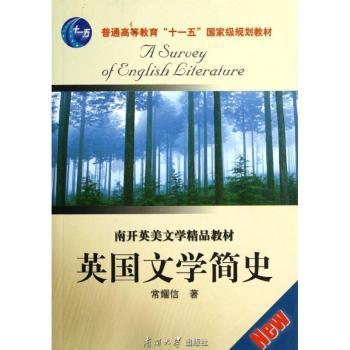内容简介
为全英文读物,是英美文学研究专家常耀信先生为广大读者奉献的又一力作。可满足学生学习与考研、教师授课与科研,以及一般性大众阅读等多种需要;它不仅在章节中设置了详细讨论题目,而且在书后配有“注释与参考资料”,列出重点研究成果问世情况,方便查索,有助于构思研究课题。可供本科生了解英国文学发展概貌与基本知识;供研究生精细研读,并助其设计学期论文作业或硕、博士毕业论文题目:供教师提炼教案、讲义;为中青年学者提供深层学术探索参考课题。
目录
ForewordChapter 1 The Old English (Anglo-Saxon)Period·Beowulf·TheMiddle English Period Beowulf·The Middle English PeriodChapter 2 Chaucer·The Pre Elizabethan Period·MoreChapter 3 The Elizabethan Age·Spenser·Sidney·MarloweChapter 4 Shakespeare·Bacon·Jonson·King James' BibleChapter 5 The 17th Century·Donne·Milton·Dryden·Bunyan·TheRestoration TheaterChapter 6 The ClassicAge·Pope·Johnson·Gray·Goldsmith·SheridanChapter 7 Movement towardRomanticism·Thomson·Young·Cowper, Crabbe·Blake·BumsChapter 8 18th-CenturyFiction·Swift·Defoe·Richardson·Fielding·Sterne·SmollettChapter 9 The RomanticPeriod·Wordsworth·Coleridge·Scott·AustenChapter 10 Byron·Shelley·KeatsChapter 11 The Victorian Period·VictorianProse·Carlyle·Mill·NewmanChapter 12 Victorian Fiction·Dickens·ThackerayChapter 13 Charlotte and Emily Bronte·MeredithChapter 14 George Eliot·Trollope·ButlerChapter 15 Hardy·Gissing·Moore·Wilde·StevensonChapter 16 Victorian Poetry·Tennyson·Browning·ArnoldChapter 17 Clough·Hopkins·Edward Fitzgerald's Rubaiyat·TheAesthetic MovementChapter 18 Victorian Drama·Shaw·WildeChapter 19 The Early 20th Century·The Edwardians·TheGeorgians·The War PoetsChapter 20 The 1920s·Woolf·JoyceChapter 21 Lawrence·Yeats·Imagism·T. S. EliotChapter 22 Poetry of the 1930s·Auden·The AudenicGroup·Thomas·EmpsonChapter 23 Fiction of the1930s·Huxley·OrweU·Waugh·Greene·IsherwoodChapter 24 Postwar PoetryChapter 25 Postwar FictionChapter 26 Postwar DramaNotes and ReferencesIndex
摘要与插图
Medieval Literature: A Brief Introduction4The date that even a child of three in England issupposed to know is
1066, the year of the conquest of England bythe French-speaking Normans.
It was the year in which the Normanscame under William the Conqueror,
and the last Anglo-Saxon KingHarold died with an arrow shot through his
eye at the battle ofHastings. It was also the year that marked the
beginning of theMiddle English or Anglo-Norman period (1066-1400). The
Norman lineof kings sat on the throne for some 90 years and gave place
to theAngevin kings (or the Plantangenets) in 1154. King Henry II and
hisdescendants stayed in power for 245 years until they weresuperseded
by the House of Lancaster in 1399 when the last of thePlantangenets,
Richard II, was dethroned. This happened just oneyear before Chaucer
died. Regarding this period there are a fewoccurrences of historic
magnitude that should be kept in mind:
(1) The Establishment
of the Feudal System:William the Conqueror did this effectively within a
short space oftime. He grabbed Anglo-Saxon land by force and gave it to
hisnobles and followers. These became lords of manors
demandingallegiance from their Anglo-Saxon serfs and owed it to
theirimmediate superiors. The hierarchy was a multi-tiered
degradationwith the king at the top keeping all the power in his hands.
Therelative peace that followed brought power and wealth and made
themilieu congenial to the growth of art and literature.
(2)
The 1381 Peasant Uprising: Within the system the nobles and the
aristocrats hadall the power and privileges while the serfs remained as
wretchedas ever. The widespread disaffection led eventually to the
peasantsrevolt in 1381 which was led by Wat Tyler of Kent and Jack Straw
ofEssex. 100,000 people marched on London, destroyed manor-houses,burnt
court papers—records of their bondage, and demanded theabolition of
serf slavery and a general pardon. Though it waseventually put down,
serfdom died out gradually.
(3) The Completion of the
Domesday Book(1086): Though undertaken as a tax-book or rent-roll to
provide theking with an estimate of his resources, the Domesday Book
servesalso as a historical record of Anglo-Saxon institutions,
customs,and way of life which would have otherwise been lost to time.



